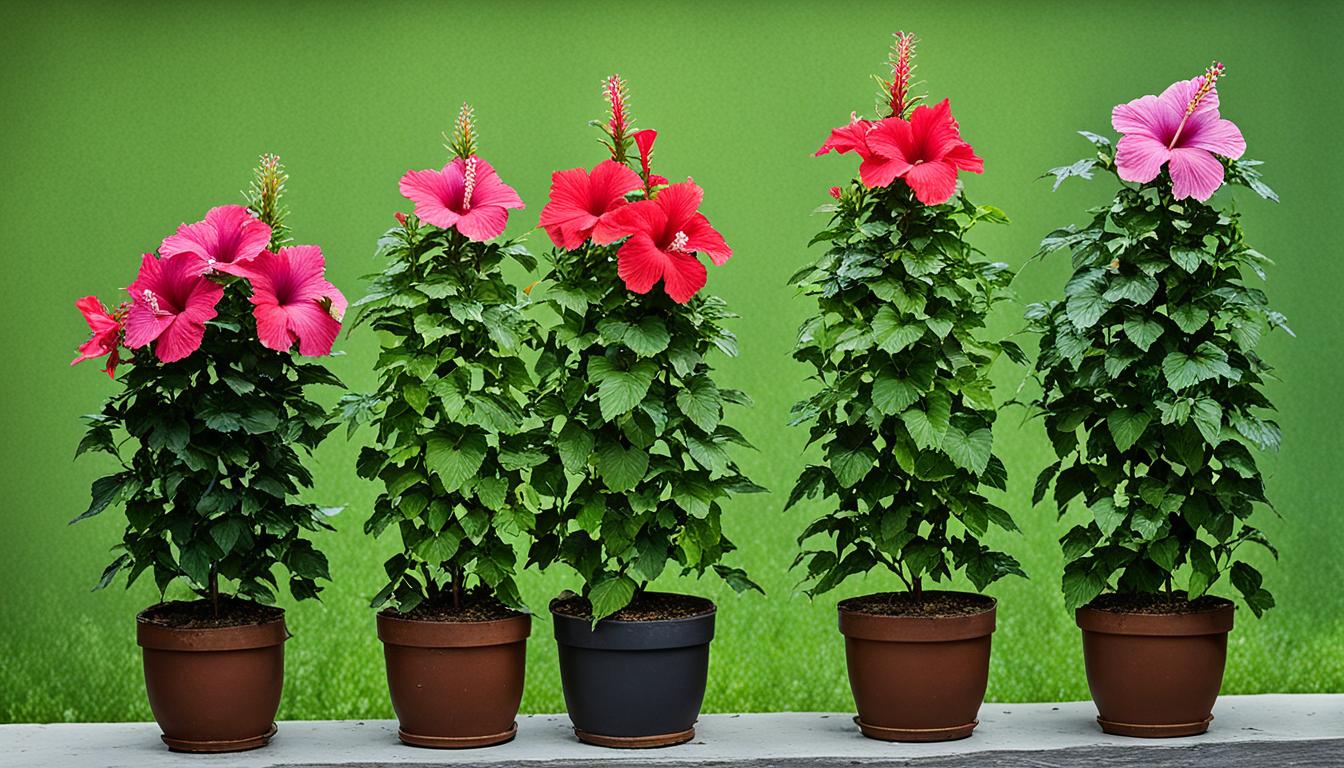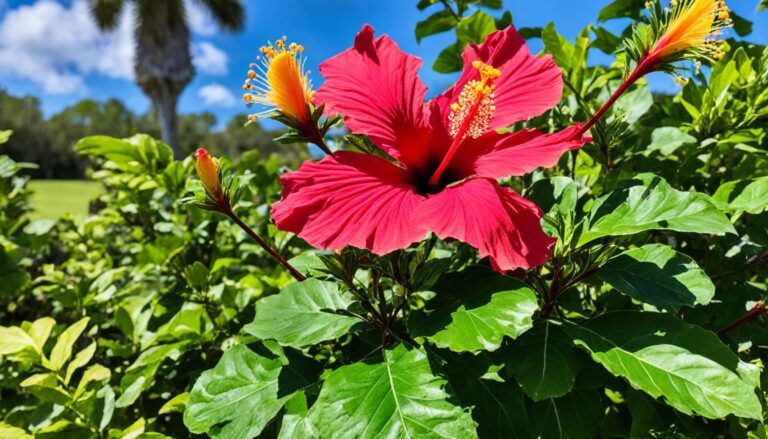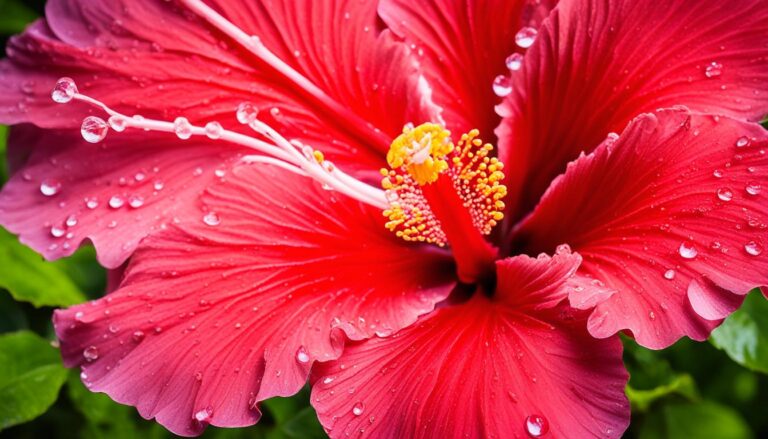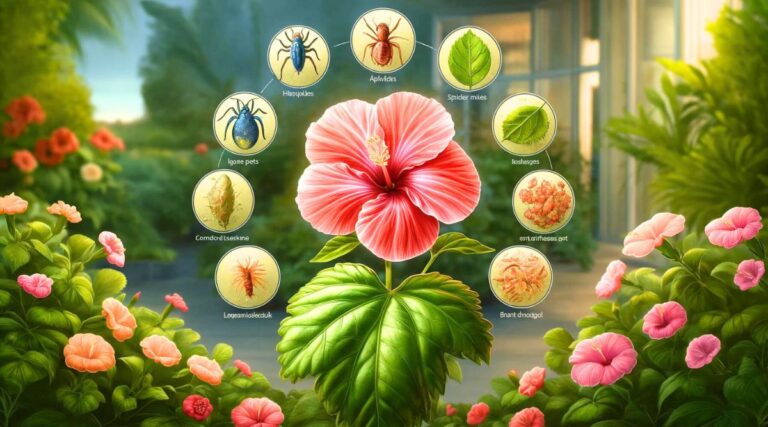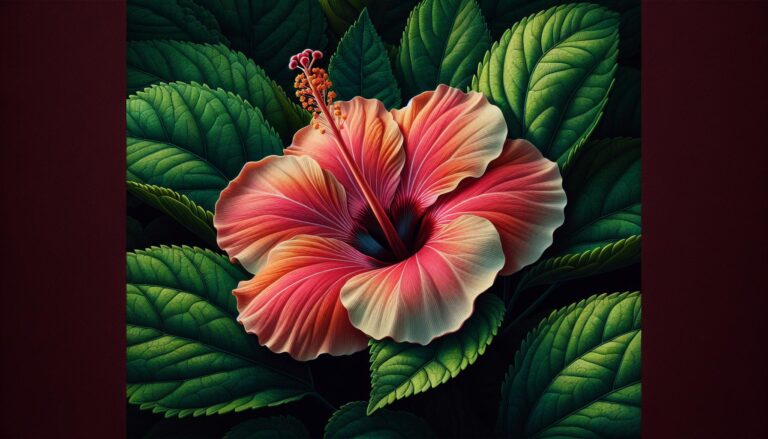Hardy Hibiscus Size Guide – Learn How Big They Get
Have you ever marveled at the beauty of a hibiscus flower? Its vibrant colors and delicate petals are truly captivating. But have you ever wondered just how big these flowers can get? Let me tell you a story that will give you a glimpse into the impressive size of hardy hibiscus plants.
Meet Sarah, an avid gardener with a passion for all things floral. She had always dreamed of having a collection of show-stopping flowers in her backyard, and when she discovered hardy hibiscus plants, she knew she had found something special. She couldn’t wait to see those large blooms in her own garden.
With great excitement, Sarah planted a few hardy hibiscus plants in the sunny corner of her yard. She carefully nurtured them, providing the right amount of sunlight, water, and nutrients. As the summer months rolled by, Sarah’s anticipation grew. Every day, she would check on her plants, eagerly waiting for those dazzling blooms.
And then, one beautiful morning, it finally happened. The hardy hibiscus plants burst into a riot of color, their magnificent flowers opening up like oversized plates. Sarah couldn’t believe her eyes. The petals were larger than she had ever imagined, measuring nearly a foot in diameter. The vibrant colors and intricate patterns were truly a sight to behold.
But it wasn’t just the flowers that impressed Sarah. As the plants grew, she noticed their remarkable size. Towering at a height of 3 to 7 feet, with a spread of 2 to 4 feet, these hardy hibiscus plants were real showstoppers. They commanded attention and added a dramatic flair to her garden.
As Sarah shared her hibiscus journey with her friends and neighbors, they too were amazed by the sheer size and beauty of these plants. Sarah’s garden became a popular destination, with everyone wanting to catch a glimpse of these giant flowers.
Now that you’ve heard Sarah’s story, you too can appreciate the impressive size of hardy hibiscus plants. Whether you’re a seasoned gardener or a beginner, these plants will make a bold and stunning addition to any garden. So, go ahead and give them a try – you won’t be disappointed!
Key Takeaways:
- Hardy hibiscus plants can reach a mature height of 3 to 7 feet and a width of 2 to 4 feet.
- The flowers of hardy hibiscus are known for their large size, measuring up to a foot in diameter.
- These plants make a bold and dramatic statement in the garden, adding a vibrant splash of color.
- Hardy hibiscus plants are a favorite among gardeners, attracting attention and admiration with their impressive size and beauty.
- Consider adding hardy hibiscus to your garden to create a stunning focal point and enjoy their breathtaking blooms.
Characteristics of Hardy Hibiscus Plants
Hardy hibiscus plants, native to North America, are known for their stunning characteristics that make them stand out in any garden. These plants boast large, showy flowers with tissue-thin, ruffled petals in a variety of vibrant shades, including pink, red, magenta, and white. Some varieties of hardy hibiscus even feature dark-colored centers, creating a striking contrast that catches the eye.
Aside from their beautiful blooms, hardy hibiscus plants also offer attractive foliage that adds visual interest to any landscape. The leaves range in color from blue-green to purple-burgundy, and their unique hues complement the vibrant flowers perfectly. With such a wide range of colors and patterns, hardy hibiscus plants can be a versatile addition to different garden styles and designs.
Hardy Hibiscus Varieties
When it comes to hardy hibiscus varieties, gardeners have plenty to choose from. Each variety has its own distinct characteristics, offering an array of options for different preferences and garden themes. Some popular hardy hibiscus varieties include:
- Cranberry Crush: This variety showcases deep red flowers with contrasting dark centers, creating a dramatic and captivating display.
- Plum Crazy: With its purple-pink flowers and deep purple foliage, this variety adds a touch of elegance and sophistication to any garden.
- Lord Baltimore: Known for its stunning scarlet-red blooms, this variety is a classic choice that never fails to impress.
- Starburst Chiffon: This variety features white petals with a hint of pink, resembling delicate chiffon fabric, and a prominent raspberry-colored eye in the center.
With such a diverse range of hardy hibiscus varieties available, gardeners can find the perfect match for their desired colors, patterns, and overall garden aesthetic.
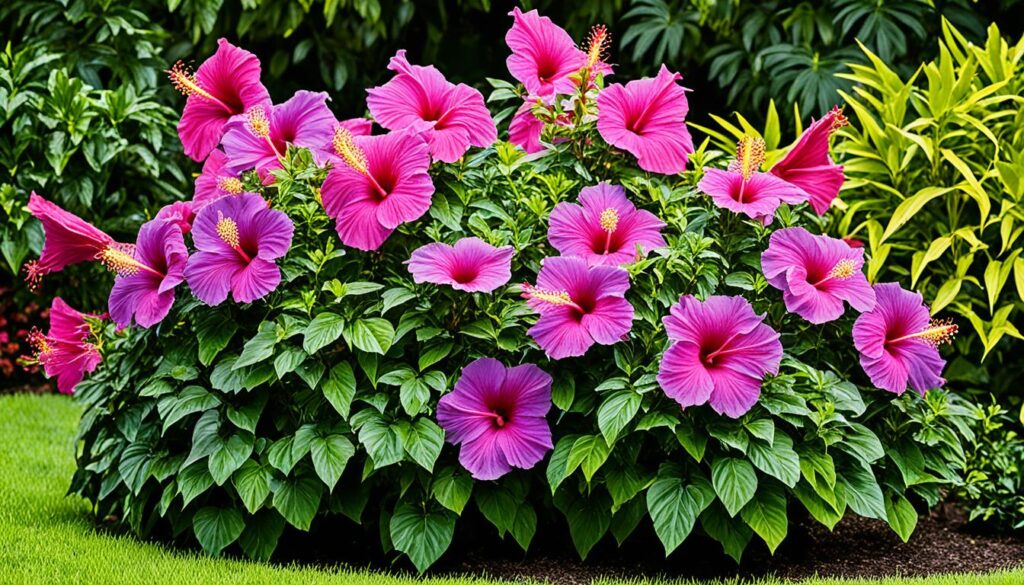
Planting and Care Tips for Hardy Hibiscus
Hardy hibiscus plants are a beautiful addition to any garden, but they require proper planting and care to thrive. Here are some essential tips to ensure the success of your hardy hibiscus:
1. Planting Location
Choose a sunny spot in your garden that receives at least six hours of sunlight per day. Hardy hibiscus plants thrive in full sun.
2. Soil Requirements
Hardy hibiscus plants prefer average, organically rich soil with a neutral to slightly acidic pH. Ensure the soil is well-drained to prevent waterlogging, which can be harmful to the plants.
3. Watering
Regular watering is essential, especially during the first growing season. Provide deep watering of at least 1 to 2 inches per week to keep the soil consistently moist. Avoid overwatering, as it can lead to root rot.
4. Fertilization
To promote healthy growth and abundant flowering, fertilize your hardy hibiscus plants. Use a diluted liquid fertilizer once a week or a slow-release fertilizer three times a year. Follow the package instructions for proper application.
5. Pruning
Prune your hardy hibiscus plants in early spring to remove any dead or damaged branches. This will encourage new growth and maintain the plant’s shape. Pruning can also help to improve air circulation and reduce the risk of disease.
With these planting and care tips, your hardy hibiscus plants will thrive and reward you with their stunning blooms. Remember to provide adequate sunlight, water, and fertilization to keep them healthy and happy in your garden.
Hardy Hibiscus Size and Growth Rate
Hardy hibiscus plants are renowned for their impressive growth rate, making them a striking addition to any garden. These plants have the potential to reach a height of 3 to 7 feet and a spread of 2 to 4 feet, creating a bold and vibrant display. However, it’s important to note that the size of each individual plant may vary based on the specific variety and the conditions in which it is grown.
The maximum size of hardy hibiscus plants is influenced by several factors, including sunlight exposure, water availability, and soil fertility. When provided with optimal conditions, these plants can grow to be quite substantial in size. Their rapid growth and generous dimensions make them an eye-catching focal point in a variety of garden settings.
To showcase the impressive growth of hardy hibiscus plants, take a look at the table below:
| Aspect | Hardy Hibiscus Growth |
|---|---|
| Maximum Height | 3 to 7 feet |
| Maximum Spread | 2 to 4 feet |
| Average Size | Varies based on variety and growing conditions |
| Factors Influencing Size | Sunlight, water, and soil fertility |
The rapid growth and impressive size of hardy hibiscus plants make them an excellent choice for gardeners seeking a dynamic and striking element in their outdoor space. Whether used as a standalone specimen or planted in clusters, these plants are sure to make a statement with their captivating dimensions.
Next, let’s explore the various methods for propagating hardy hibiscus plants to expand your collection and enjoy their beautiful growth in different areas of your garden.
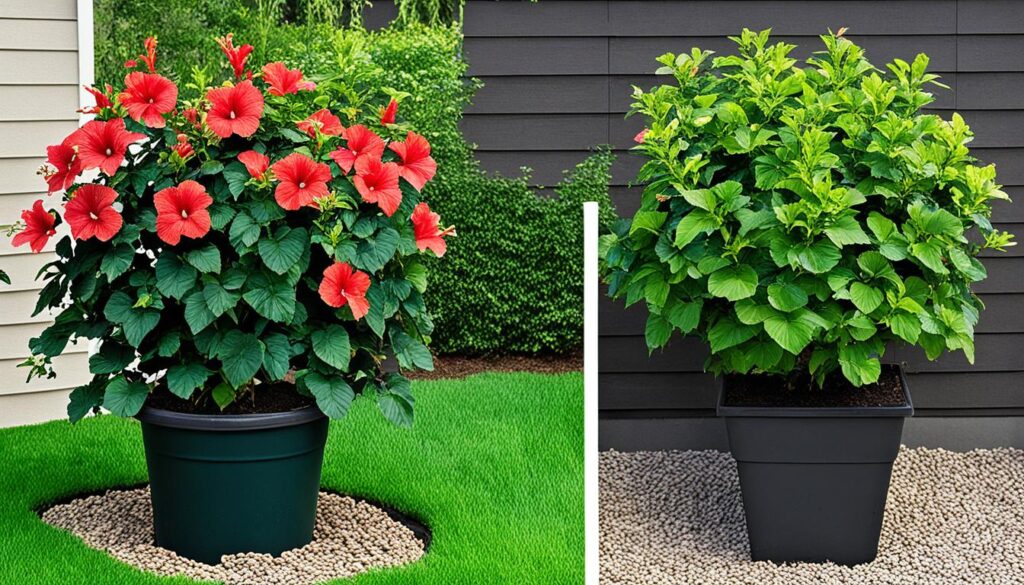
Hardy Hibiscus Propagation Methods
Looking to expand your hardy hibiscus collection? Fortunately, there are two effective propagation methods: stem cuttings and seeds. Whether you prefer to multiply your favorite varieties or experiment with new hybrids, let’s explore these propagation techniques.
Stem Cuttings
Propagating hardy hibiscus through stem cuttings is a popular method that ensures genetic consistency with the parent plant. Here’s how to do it:
- Choose a healthy stem with vigorous new growth in the spring or early summer.
- Using clean pruning shears, make a clean cut just below a node, which is where a leaf joins the stem.
- Dip the cut end of the stem in rooting hormone to encourage root growth.
- Plant the cutting in a container filled with a moist growing medium, such as a mix of perlite and peat moss.
- Place the cutting in a warm location with indirect sunlight and maintain consistent moisture in the soil.
- After several weeks, you’ll notice new leaves appearing, indicating successful root development.
- Repot the cutting in a larger container and continue to care for it until the last frost has passed.
- Finally, transplant the rooted cutting into the ground or a larger pot to enjoy its beautiful blooms.
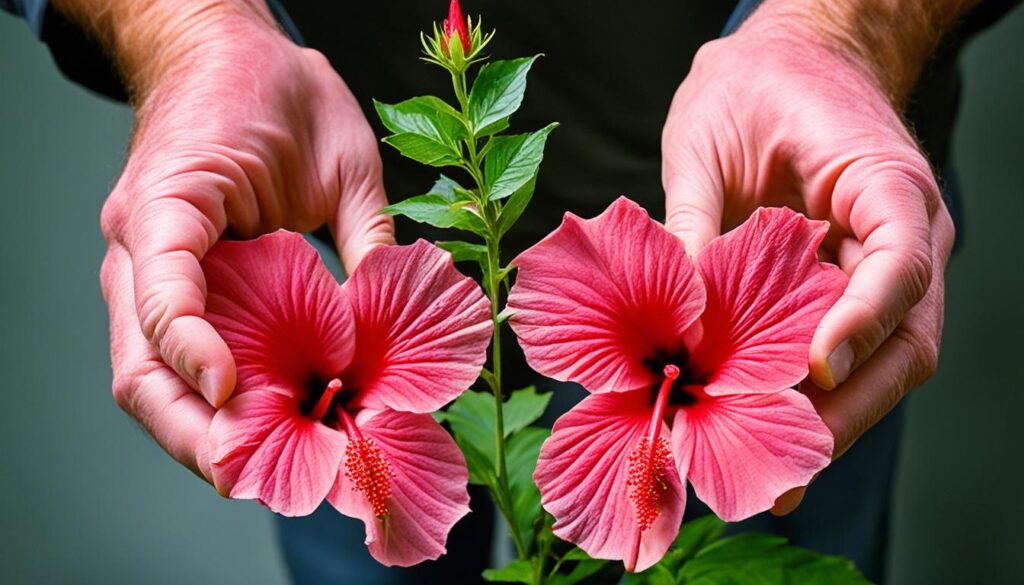
Seed Propagation
For a more adventurous approach, hardy hibiscus seeds can be used for propagation. Here’s what you need to do:
- Soak the hardy hibiscus seeds in water overnight to improve germination.
- To break down the seed coat and encourage sprouting, scarify the seeds by lightly scratching the outer surface with sandpaper or a small knife.
- Sow the scarified seeds in a seedling pot filled with well-draining, quality seed starting mix.
- Gently press the seeds into the soil without burying them, as they require light for sprouting.
- Place the pot in a warm location with indirect sunlight, and keep the soil consistently moist.
- Once the seedlings have grown several sets of leaves, they can be transplanted into larger pots or directly into the ground.
Now you have two reliable methods for propagating hardy hibiscus plants. Whichever route you choose, patience and proper care will yield beautiful, vibrant blooms in no time. Happy gardening!
Overwintering Hardy Hibiscus Plants
Hardy hibiscus plants are a beautiful addition to any garden, but they require special care during the winter months. In regions where winter temperatures drop below zone 4 or 5, it is important to protect the plants from freezing temperatures. Fortunately, there are several strategies for overwintering hardy hibiscus plants and ensuring their survival.
Protecting Hardy Hibiscus in Winter
One method of protecting hardy hibiscus plants in winter is to wrap them in a heavy cloth or tarp. This will provide insulation and shield them from freezing temperatures. Be sure to secure the wrap tightly around the plants, ensuring that no cold air can reach them. This method is especially effective for plants in the ground.
If you have hardy hibiscus plants in containers, you can bring them indoors during the winter months. Choose a location that maintains a temperature of around 55 degrees Fahrenheit. This might be a basement, garage, or any other cool but frost-free area. Keep in mind that the plants still need sunlight, so place them near a window or provide supplemental grow lights.
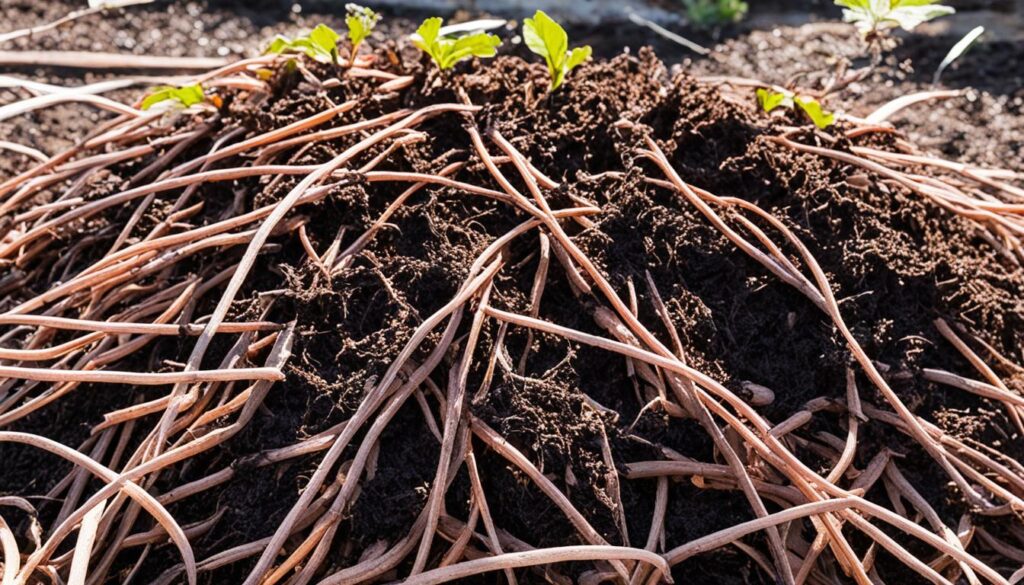
Overwintering Hardy Hibiscus in Containers
When overwintering hardy hibiscus plants in containers, it is important to take additional precautions. First, make sure the containers have adequate drainage holes to prevent waterlogging. Excess moisture can be detrimental to the plants during the dormant period.
Before moving the containers indoors, trim back any dead or damaged foliage. This will help reduce the risk of pests or diseases taking hold in a confined indoor space. Clean the containers thoroughly to remove any pests or debris that might have accumulated over the growing season.
During the winter months, water the plants sparingly, allowing the soil to dry out slightly between watering. Be careful not to overwater, as this can lead to root rot. Fertilization is not necessary during the dormant period, as the plants are not actively growing.
Common Pests and Diseases of Hardy Hibiscus
Despite their resilience, hardy hibiscus plants are not immune to common pests and diseases. Regular inspection and preventive measures can help maintain the health and beauty of your plants.
Pests
Hardy hibiscus plants can attract various pests, including aphids, Japanese beetles, mealybugs, spider mites, thrips, and whiteflies. These pests can damage the leaves, stems, and flowers of the plants.
To control these pests:
- Inspect your plants regularly: Monitor the leaves and stems for the presence of pests.
- Remove pests manually: If you notice any pests, consider removing them by hand or using a strong spray of water to dislodge them.
- Apply insecticidal soap: Use insecticidal soap or neem oil according to the instructions on the label to control and prevent pest infestations.
Diseases
Hardy hibiscus plants can also be affected by fungal diseases, particularly in humid and moist conditions. The most common fungal diseases that affect hardy hibiscus include leaf spot, blight, and rust.
To prevent and treat fungal diseases:
- Proper spacing: Ensure adequate spacing between plants to promote airflow and reduce humidity, preventing the spread of fungal diseases.
- Water at the base: Avoid overhead watering, as this can promote the growth and spread of fungal diseases. Water at the base of the plants instead.
- Treat with fungicides: In severe cases of fungal infections, applying a suitable fungicide may be necessary. Follow the instructions on the label for application.
Common Pests and Diseases of Hardy Hibiscus
| Pests | Diseases |
|---|---|
| Aphids | Leaf spot |
| Japanese beetles | Blight |
| Mealybugs | Rust |
| Spider mites | |
| Thrips | |
| Whiteflies |
By being vigilant and taking appropriate measures to control pests and prevent diseases, you can ensure the continued health and vitality of your hardy hibiscus plants.
Tips for Maximizing Flowering of Hardy Hibiscus
Hardy hibiscus plants are known for their stunning blooms, and to ensure your plants reach their full blooming potential, it’s important to provide them with the right conditions and care.
Sunlight and Temperature
Hardy hibiscus plants thrive in temperatures between 65 and 75 degrees Fahrenheit. To promote abundant blooming, make sure your plants receive at least six hours of full sun each day. In shady conditions, the plants may struggle to bloom, so it’s important to choose a sunny location for optimal flowering.
Watering and Fertilization
Proper watering and fertilization are essential for encouraging blooming. Hardy hibiscus plants require regular watering to keep the soil consistently moist. Water deeply, providing at least 1 inch of water per week, especially during dry spells. Fertilize your plants regularly with a liquid fertilizer or slow-release fertilizer to provide them with the necessary nutrients for healthy growth and abundant blooms.
Spring Growth and Patience
Hardy hibiscus plants may take their time to start growing in the spring, so it’s important to be patient. They often delay their growth until the weather becomes consistently warm. Avoid jumping to conclusions or assuming your plant has a blooming problem during this period. Provide your plants with the right conditions and wait for them to flourish on their own schedule.
Factors Affecting Blooming
If your hardy hibiscus plants are not blooming as expected, several factors may be at play. Lack of sufficient sunlight is a common cause of poor blooming. Ensure your plants are receiving the necessary hours of full sun each day. Additionally, inadequate water or poor soil fertility can also impact flowering. Make sure your plants are adequately watered and consider soil testing to determine if any necessary amendments are needed.
Remember, each hardy hibiscus plant has its own unique blooming characteristics, and some varieties may naturally have fewer blooms than others. By providing your plants with the right conditions, regular care, and a little patience, you can maximize the flowering potential of your hardy hibiscus plants and enjoy their vibrant blooms all season long.
| Factors for Maximizing Hardy Hibiscus Flowering | What to Do |
|---|---|
| Provide ample sunlight | Ensure plants receive at least six hours of full sun each day |
| Maintain consistent soil moisture | Water deeply, providing at least 1 inch of water per week |
| Fertilize regularly | Feed plants with a liquid or slow-release fertilizer according to package instructions |
| Be patient in spring | Allow plants time to start growing on their own schedule |
| Ensure sufficient sunlight | Avoid shady conditions that may prevent blooming |
| Provide adequate water | Ensure plants receive consistent and adequate moisture |
| Consider soil fertility | Test soil and amend as necessary to provide optimal growing conditions |
Growing Hardy Hibiscus in Containers
Hardy hibiscus plants can bring vibrant beauty to any garden, but did you know they can also thrive in containers? Whether you have limited space or simply prefer the convenience of container gardening, growing hibiscus in pots can be a rewarding experience. With proper care and attention, you can enjoy the stunning blooms of hardy hibiscus right on your patio or balcony.
When selecting a pot for your hibiscus, choose one that has adequate drainage holes to prevent waterlogging. This will ensure that the roots stay healthy and prevent the risk of root rot. Plant your hibiscus in a high-quality potting mix, making sure that the crown of the plant sits slightly above the soil surface. This will help prevent water from pooling around the stem and causing rot.
Watering is crucial for container-grown hibiscus. These plants may require more frequent watering compared to those planted in the ground. It’s important to water thoroughly, allowing excess water to drain out of the pot. Be mindful not to let the soil dry out completely between waterings, as hibiscus plants prefer moist soil.
In addition to regular watering, fertilization is essential for the proper care of potted hardy hibiscus. Use a balanced liquid fertilizer or a slow-release fertilizer specifically formulated for flowering plants. Follow the instructions on the fertilizer packaging to determine the appropriate amount to use and the frequency of application. This will help provide the necessary nutrients for healthy growth and abundant blooms.
When it comes to sunlight, hibiscus plants are sun-loving beauties. Place your container-grown hibiscus in a location where it can receive at least six hours of direct sunlight each day. If you’re growing them indoors, choose a sunny spot near a window or supplement with grow lights to ensure they get sufficient light.
During the winter months, you can choose to bring your potted hibiscus indoors for overwintering. Make sure they are placed in an area with temperatures around 55 degrees Fahrenheit. This will help the plants go dormant without experiencing extreme cold. Provide them with adequate sunlight to maintain their health and vitality throughout the winter.
Tips for Growing Hardy Hibiscus in Containers:
- Choose a pot with good drainage holes to prevent waterlogging.
- Plant hibiscus in a high-quality potting mix, ensuring the crown is slightly above the soil surface.
- Water thoroughly and allow excess water to drain out of the pot.
- Fertilize regularly with a balanced liquid fertilizer or slow-release fertilizer.
- Provide at least six hours of direct sunlight each day.
- Consider overwintering potted hibiscus indoors in a location with temperatures around 55 degrees Fahrenheit.
By following these tips and giving your container-grown hardy hibiscus the care they need, you can create a stunning display of colorful blooms right at your doorstep. Whether you have a small balcony or a spacious patio, growing hibiscus in pots allows you to enjoy the beauty of these plants wherever you are.
Conclusion
Hardy hibiscus plants are a stunning addition to any garden, offering large, vibrant flowers and attractive foliage. These plants can reach impressive sizes, with heights ranging from 3 to 7 feet and spreads of 2 to 4 feet. Their showy blooms and colorful foliage create a bold statement that will surely catch the eye of any visitor.
Fortunately, caring for hardy hibiscus plants is relatively easy. They thrive in full sun and require moist soil for optimal growth. Regular fertilization will keep them healthy and encourage abundant flowering. Propagation can be done through stem cuttings or seeds, giving you the opportunity to expand your collection or share these beautiful plants with friends and family.
Overwintering hardy hibiscus plants and protecting them from pests and diseases are crucial for their long-term success. Proper insulation during winter and diligent pest control can help ensure the plants’ health and vitality. With the right care and attention, your hardy hibiscus plants will reward you with a season of stunning blooms that will bring joy and beauty to your garden.

